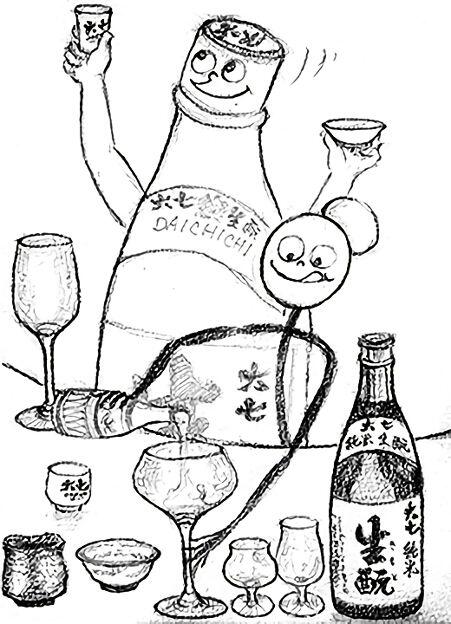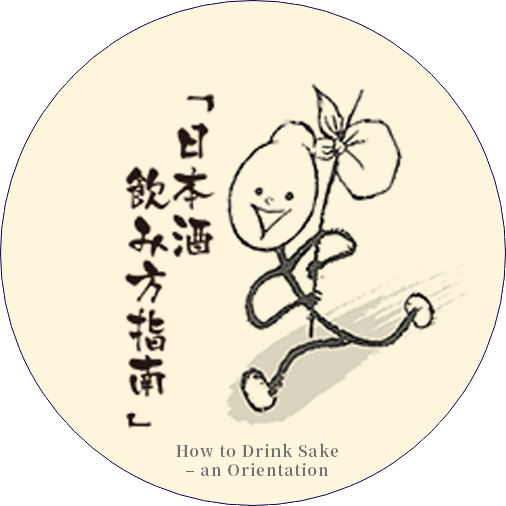| Yeast |
“Kimoto, the vessels from which we drink sake, come in various shapes and materials.” |
| Kimoto |
“You’ve noticed something important! The traditional vessel is the lacquered hirahai (flat sake cup) which today is only used at Shinto ceremonies. In the Edo period, choko or cylindrical cups became popular. And the name guinomi seems to have been given to large cups by the Showa period ceramic artist Rosanjin Kitaoji.” |
| Yeast |
“I see. Today the hirahai is still used during the sansankudo wedding ceremony in Shinto shrines. It creates a very graceful atmosphere!” |
| Kimoto |
“Because of the custom to drink from hirahai, we had such artistic implements in the past as haisen (bowls for rinsing sake cups) and haidai (stands for sake cups). |
| Yeast |
“Uh-huh, sake vessels developed together with rituals. Nowadays we pay in the first place attention to the beauty and functionality of the vessel.” |
| Kimoto |
“True. In fact, aroma and taste change slightly depending on the size of the vessel. Also the material has a subtle influence.” |
| Yeast |
“What vessel would you advise for ginjo and daiginjo, for example?” |
| Kimoto |
“In order to enjoy the rich aroma, use a large wine glass and pour the sake until about 1/3. That allows you to appreciate the various aromas rising up in the glass. You can also enjoy the complexity, which is unnoticeable in a small sake cup or shot glass. Riedel has brought out a special daiginjo glass.” |
| Yeast |
“That will surely taste delicious! Daishichi was also involved in the development of that daiginjo glass.” |
|
 |
| Kimoto |
“The daiginjo glass by Riedel is excellent, but especially in the case of powerful sakes like Horeki Daishichi and Myoka Rangyoku, I recommend their Montrachet glass with an even larger bowl. Then the rich and complex aroma and umami will blossom in a very gorgeous way.” |
| Yeast |
“Wow! Are wine glasses also best in the case of junmai and honjozo sakes?” |
| Kimoto |
“Hmm. When looking for functionality, wine glasses will be a good choice. Especially those with thin glass will be fine. World famous Japanese sommelier Shinya Tasaki has designed four different sake glasses, for fragrant sake, deep-tasting sake, light sake and matured sake. We use two of these in the tasting room in the Daishichi Sake Brewery. Recently, Riedel has also developed a very nice special junmai glass. But as the pleasure of sake is something more comprehensive than only functionality, we should also look at ceramic ware.” |
| Yeast |
“Yes, yes! I know you love ceramic ware!” |
| Kimoto |
“When drinking sake warm, ceramics also have a useful functional aspect. Earthenware is porous and therefore doesn’t transfer heat very well to your hand, while the fine oxygen that can seep through, makes the sake softer.” |
| Yeast |
“Well, which form is best for ceramic ware?” |
| Kimoto |
“A flat cup with a large opening allows us to enjoy the aroma as well. Cylindrical sake cups, both large guinomi and small choko, fit well in the hand and allow you to enjoy the - of warm sake. But more important than functionality is your own preference.” |
| Yeast |
“I see. Which types of sake vessels are popular in Japan?” |
| Kimoto |
“There is an old expression: ‘A sake flask from Bizen ware and a sake cup from Karatsu ware.’ The expressiveness of a high-fired, unglazed sake flask of Bizen ware and the at first sight simplicity of a tasteful cup of mottled Karatsu ware or Korean Karatsu ware, form a prized combination. I’m happy to have been born in ‘ceramics kingdom’ Japan!” |
| Yeast |
“Yes! History and culture are important elements when enjoying sake. Thanks a lot, Kimoto!” |
| Kimoto |
“When you pay attention to what kind of vessel you drink sake from, your enjoyment will increase!” |





